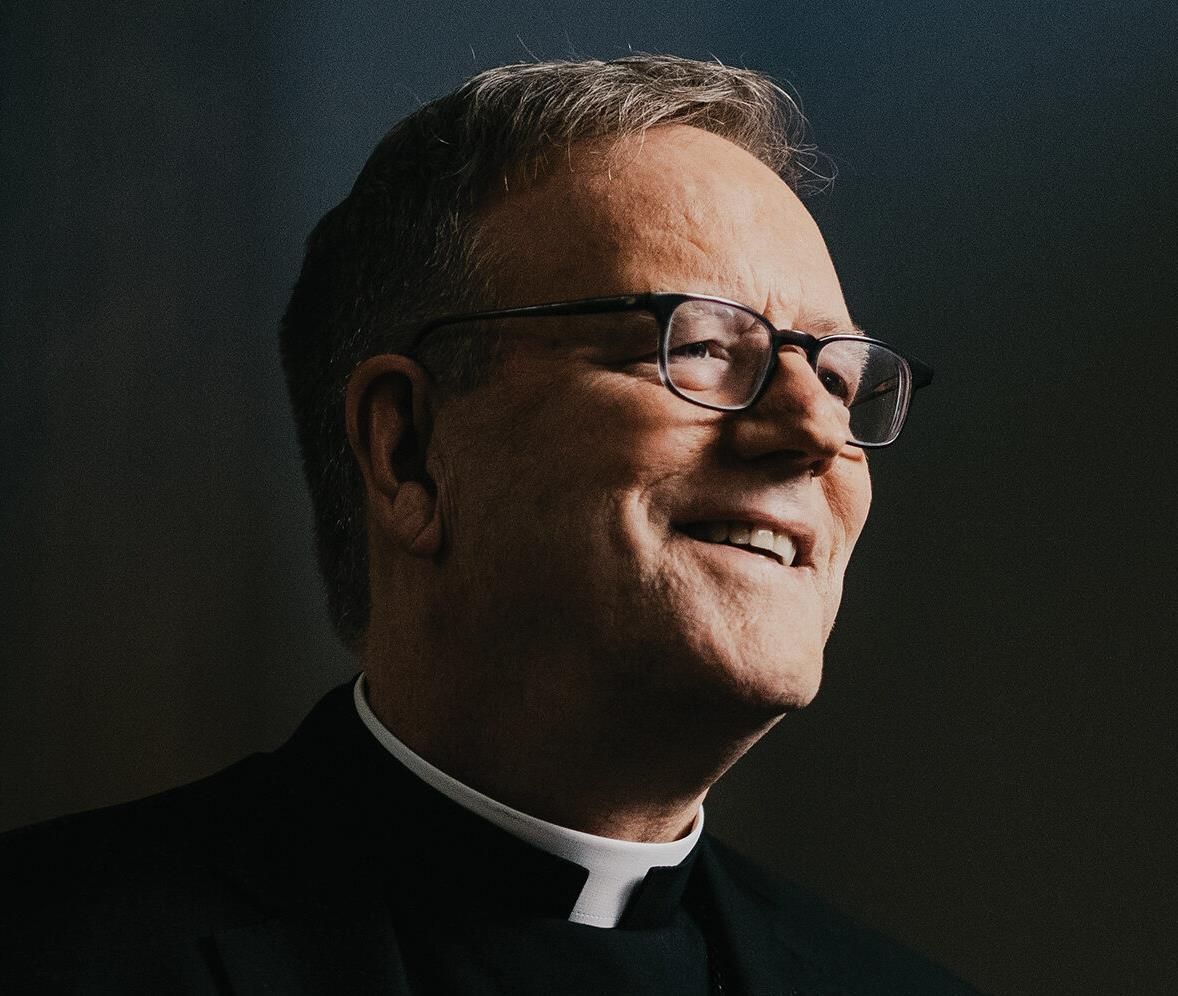The History of the Church of St. Martin
1878-1881
A century ago, and more, when some of our grandparents and great-grandparents were but teenagers and the land lay open and free, men and women, most of whom were married, and a few singles, settled the Coteaudes Prairies of Minnesota's far southwest corner. Where small towns, farmsteads, and decimated tree claims now make up this landscape, the settlers of the 1870's experienced an undulating prairie of little definition, save for the silhouette of the hills, the meandering streams, and the occasional slash of a ravine. As you stand amid this vast sea of grass, your heels sinking into the rich loess; a soft, scented breeze brushing your face; the scudding clouds overhead, visualize for a moment a dark speck on the far horizon to the east. As it moves nearer, you can make out a lone horseman cantering toward you. When he nears, he dismounts, and leads his horse to where you stand. This could have been blond-haired, 6 '2" Father Charles Koberl, resident pastor of St. Rose of Lima, Avoca, who had come to minister to the Catholics of the Woodstock area.
But we are ahead of our story: Father Koberl was a native of Austria where, presumably, he received his seminary training and ordination in March, 1869. Bishop John Ireland made a wise choice when, in 1878, he appointed this strong, dedicated, practical priest to Avoca. He had all the necessary ingredients for success on a new frontier, being a superb horseman and a gifted linguist.
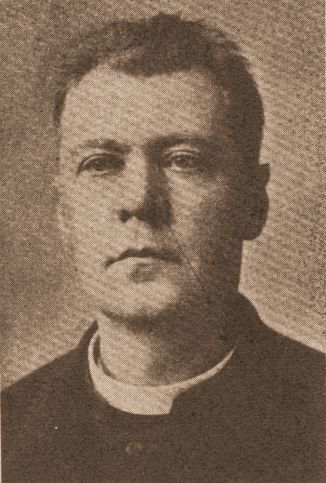
Father Koberl ministered to numerous settlers in his extensive parish of Avoca, which stretched from Fairmont, Minn., to Flandreau, S.D. Some could be reached by rail line, the others, preferably by horseback, buggy being more tiring. In this age of no roads, the priests preferred to baptize the very young in their homes, and take Holy Communion to those too aged or infirm to get to church.
Concomitant with the arrival of Father Koberl was that of the settlers themselves. In late January, 1878, Michael O'Mahoney arrived from Olmstead County. In March, other families: E.W. Powers, N.J. Powers, John and Richard Shea, Pat and J.J. Hartigan, John and Walter McNallan (distant relatives of Father Hilary McNallan), and William Ryan all drove from Wabasha County. That spring, O'Mahoney and E. W. Powers were among the first to break sod. An interview with the latter stated: 'When he hauled his lumber from Luverne, there were no roads and he had to travel using maps and a compass, and on the way was one sod shanty where Edgerton is and a few near Luverne.'
There is no record of Father Koberl's Masses in Woodstock during 1878, but there were at least two baptisms: Frances and David Soules, Lowville, Murray County. If not a whole lot richer spiritually for the Catholics, the year of 1879 saw the organization of Burke Township. Worthy of mention here, was the terrible misfortune of John Wingle's loss of two horses within a week to lung fever. The first baptism in Burke Township was that of Briget O'Mahoney, September 9th. Because the village of Woodstock had been only recently platted and yet without any buildings, Mass had to be offered elsewhere, hence the celebration of it in late October, 1879, at the Post Office Hall, Pipestone.
The year 1880 was a mix of parish activity, joy and sorrow, and some spiritual growth. The M.D. Moriaritys lost an infant son in January. An item in the Pipestone County Star* mentioned that M.C. O'Mahoney was preparing to prove-up his government claim, one of the first in the county to do so. When Daniel Duggan moved to his farm southwest of Woodstock in April, he brought with him from St. Paul the best stock to be found in the county. Father Koberl offered Mass in Pipestone for the Catholics of the county on May 14th and again on June 20th, and didn't return until early October. It was well that he came when he did.
October 14th saw the beginning of the terrible winter which lasted until April 18, 1881. Shoveled out of one blizzard, another was in its wake. The temperatures dropped, trains did not run for weeks at a time (which meant no mail), fuel and food became scarce, and farmers did their chores by going through tunnels, some even entering through the roofs of their barns. In the midst of it, young P. Hartigan lost an arm in a threshing accident in late November and died a few days later. In January, 1881, the M.D. Moriaritys lost another infant, their second in as many years.
Father Koberl's next assignments were in St. Paul. His last years were at Sacred Heart parish which he established, going to his Maker on February 20, 1899.
*Hereafter referred to as the Star.
Father William John Keul was an Easterner, ordained at the early age of 28. His bishop evidently gave him permission to go west, where he was incardinated into the St. Paul Diocese. He had had previous assignments at Currie and Avoca before coming to Woodstock about October 1, 1881.
Catholicism was taking a sense of permanence and official status in Pipestone County in this era. It is evidenced by an item in the Star, January 12, 1882, which said:
'To the Catholics of Pipestone County.-Services will be held at the residence of W.H. Ryan, in the town of Burke, southeast corner section 14, on Friday, January 13th, and thereafter services will be held every Friday, or twice a month. Edgerton, Pipestone, and Woodstock are now one parish. By authority of Rev. Father Keul, Avoca.'
By mid March, 1882, a road was built from Pipestone to Woodstock. Now teams could move cords of stone, purchased from c.c. Doodnow's quarries to the site of the new and first Catholic church in Woodstock, the same site on which the church now stands. The number of cords, or the price ($2.50 @?) is not known. Josh L. O'Dell was possibly the stone mason, as he had done work in Woodstock in late April and early May, 1882.
Meanwhile, what could have been the first home wedding in the parish, occurred between William Ryan, Luverne, and Annie Clifford, Hatfield, at the residence of W.H. Ryan on January 13, 1882, Father Keul officiating. In mid June, Morris Moriarty had obtained a license to open a 'Gin mill' in Woodstock. The temperance society, known as St. Patrick Abstinence Society, had its hands full.
The parish continued to grow. There were the joys of births, contrasted by tragic deaths. M.D. Moriarty family lost three children in three years. The drama that unfolded at the Michael C. O'Mahoney home was probably the single, greatest tragedy to have happened to a family in the history of the parish: over a 10-day period in early September, 1883, they lost four children to the scourge of diphtheria. The names of those four children are uniquely engraved on the O'Mahoney tombstone in St. Martin cemetery. The oldest daughter, Kate, was spared. Yet, the grief of the family must have been profound beyond telling.
In mid October, the Catholic community of Woodstock, Pipestone, and Edgerton bid adieu to Father Keul, who, from an article in the Star, April 11, 1890, had some sort of serious problem, for it said:
'Fr. Wm. Keul, whom many of our older residents will remember as once having charge of the Catholic flock throughout this section, and who went to the bad and was fired by the church, is now said to be an Episcopal clergyman in Milwaukee'. This item has not been authenticated, but it is reason enough to believe that he repented and later, in 1900, became a Benedictine. In religion, he went by the name of Father Fidelis. He was known as 'Pop' to his confreres and 'Fiddlesticks' to his students. He taught history and English in a Newark, New Jersey, college until his death November 6, 1922. His remains rest in St. Mary Cemetery, East Orange, New Jersey.
1883-1885
Father John Conway, who was born in Kilkenny, Ireland, was the first foreign priest to serve the Woodstock area. He received his training and was ordained at Maynooth, Ireland in 1878. He was a scholastic giant, ranking first in Moral Theology and Sacred Scripture, second in Dogmatic Theology, won a prize in church history, and pursued a course in advanced theological study.
Five years later, Father Conway arrived, first in the Diocese of St. Paul, then in the fall, at Avoca, to pick up where Father Keul left off. In late October, 1883, he offered Mass in the Woodstock school. On this occasion 'all Catholics of Woodstock and the surrounding district were requested to attend, as some most important business must be transacted.' The nature of the unstated, business was soon brought to light. One November 11, after Father had heard confessions and said Mass, the congregation met to consider means for a proposed new church. The next issue of the Star, November 15, stated:
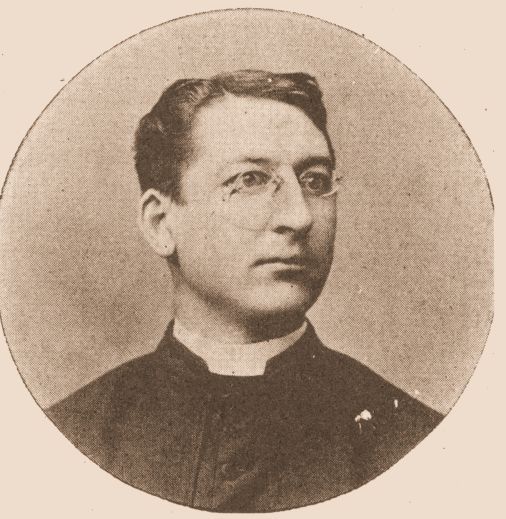
Woodstock is still on the "boom," The Catholic Society is getting ready to put up a church, 28 x 50 feet, 16 foot posts, which will be an ornament to our town. Perry and Eyland have the contract for furnishing the lumber. Ed Wilkins has the building contract, and will push the work along as fast as the weather permits.'
The parish was then incorporated as the 'Church of St. Martin of Woodstock, Minnesota.' The name was quite likely prompted by Bishop John Ireland as a remainder of his years in France, whose great apostle is St. Martin of Tours. The official articles of incorporation are dated, December 20, 1883, and bear the personal signatures of Bishop John Conway, Michael C. O’Mahoney and John Wingle (lay members). Thus, the first Catholic parish in Pipestone County was established.
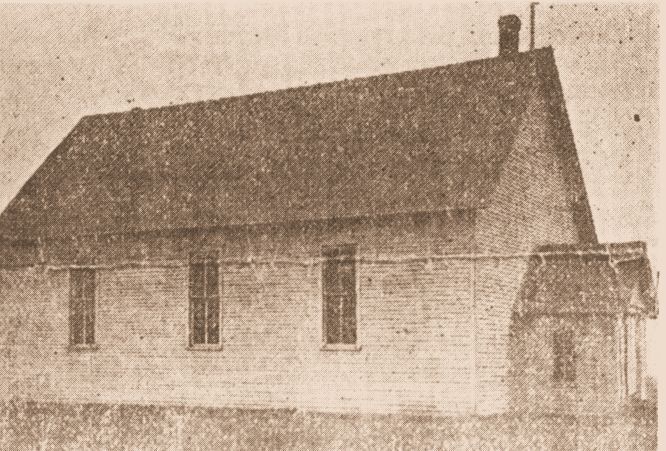
Construction got underway in mid January, 1884. A temporary setback occurred when a stiff northwest wind blew down the raised frame of the church. Ed Wilkins and his crew had the structure ready for the first Mass, Tuesday at 10:30, June 17, 1884. More serious was the savage July storm that moved the building from its foundation. This did considerable damage. Later in July, 1884, Thomas Grace resigned as Bishop of the Diocese of St. Paul, to be replaced by John Ireland, his auxiliary.
Early October saw the beginning of a cemetery, formerly known as St. Bridget, but more about that later. In this era, the parish was growing and thriving, consisting of about forty families, many of Irish descent. To have Mass on one Sunday a month plus some weekday Masses was, at this time, considered a great accomplishment.
Residents were anxious for security of their homestead (Homestead Act, by President Lincoln, in 1862, granting ownership after five consecutive years, plus certain stated improvements). In February, 1884, Patrick Hartigan made such final proof. Father Conway saw need for the community to build or acquire a rectory.
In November of 1884, John and Rosanna O'Neill, with their nine children, moved to Woodstock from Canada. Two of these, Fannie and Francis, would later enter the religious life.
Father Conway was active in both the social and spiritual dimensions of his parishioners. He staged the first of the Church Fairs from December 28, 1884, to January 1, 1885. Supper was served each evening with amusement following. Shortly before his departure, he arranged a mission, to be conducted by Father Alex Doyle O.P.
It was time to say farewell to Father Conway. He returned to St. Paul, where he taught at St. Thomas Seminary, 1886-1887. In 1887, he organized and founded St. James parish, St. Paul. From 1889-1893, he was one of the priest editors of Northwestern Chronicle. During the next twenty-three years, he edited several Books and magazine articles, some controversial. Suspicion suggests that Father Conway took 'French Leave' of the priesthood. No record of his death or burial has been found.
1885-1890
Ah! but 'not to worry,' as the Irish were wont to say. Father Francis Patrick Kervick followed on the heels of Father Conway, and was to stay in Woodstock longer than any priest ever had, even to the present day, but it would always be as a missionary rather than a resident priest.
Father Kervick was born in Baltimore, Maryland, one of seven children in an impoverished family, two of whom would become priests, and two would become nuns. After ordination in London, he sailed to the United States in 1881. He served several mission assignments before coming to St. Martin in October, 1885. Avoca was the mother parish; Fulda, Pipestone, and Woodstock would be missions.
Father Kervick lost no time, and the parish entered into its first mortgage. It borrowed $300 at 100% interest from a parishioner, Daniel Duggan. As collateral for the loan, Duggan held a mortgage on lots 7 and 8, Block 15, and he demanded that the church be properly insured for $400.
To meet the social needs of his parishioners, Father Kervick followed the lead of his predecessor by having a 4-day fair that ended on Christmas eve, ending with a dance. Proceeds were $150.76, a generous amount.
In July, 1886, a puzzling item from the Star, under "Woodstock Whittlings" stated that the Woodstock church was plastered and ready for occupancy; hence the reason for the mortgage.
Tradition has it that the first church was never dedicated, but the facts speak for themselves. An article in the Star stated: "The new Catholic Church in Woodstock will be dedicated Sunday, August 22, 1887. Rev. F.P. Kervick will officiate." That the pastor should dedicate a church in a mission territory is not surprising, but what is curious is that a generous three and one-half weeks later, September 16, Bishop John Ireland, himself, administered the Sacrament of Confirmation to the Catholics of Woodstock and Pipestone in St. Martin newly plastered church. Was Father Kervick so impetuous that he could not have waited for the bishop to dedicate the church on the same occasion as the conferring of Confirmation?
During the winter of 1887, storms prevented Father Kervick from getting to Woodstock as often as scheduled. Three times he had been stranded, and he decided to stay close to Avoca. He resumed his schedule after Easter, but in the meantime, a number of Catholics from Edgerton had been put in his charge. Up to now, he could make his rounds by train: with Edgerton on his list, it meant horse and buggy. He sometimes offered Mass at Woodstock and Edgerton on the same Sunday.
Father Kervick experienced a real baptism of cold and snow with the famed blizzard of 1888, the blizzard the settlers used for marking events as happening either before or after that storm. The Sioux City Journal described that 12th day of January in these words: "By 3:00 p.m., the storm had reached a degree of severity to wipe out all former records, and yet the fury of the elements increased until 9:00, at which time, the storm resembled a raging, whirling, dashing tempest. The dreadful cold, with wind and snow, made it dangerous for people to be out of doors. The storm was absolute monarch of the highways." Loss of livestock was heavy. James Jackson lost the greater part of his pureblood herd. Jackson was the Scotsman who spent the greater part of his lifetime in the Woodstock area, and who in the early 40's, embraced Catholicism. His death occurred February 3, 1943, his burial in Woodlawn cemetery, Pipestone, Father Hilary McNallan in charge.
On occasion, Father Kervick staged a spiritual blitz. Dedicated to the Catholics in his charge, he went from place to place, day after day, tending his flock. One such schedule was thus: April 23, 1889, at the P. Kelley residence, Ellsborough Twp. (Murray Co.); April 24 at the Chris Hogan residence, Fountain Prairie; April 25 at the John Gilronan residence, Altoona; April 26 at the James Dixon residence, Sweet; April 27 at Pipestone, April 28 at Woodstock; and April 29 at Edgerton.
In September, 1889, Bishop Ireland visited southwestern Minnesota, and he spent a few days with Father Kervick at Avoca. No doubt the bishop wanted to inform the pastor of the contemplated changes for the Diocese of St. Paul. Of importance to the Catholic settlers of Pipestone County, was the division of the Diocese of St. Paul into the Dioceses of Duluth, St. Cloud, and Winona on November 2, 1889. A month later Joseph Bernard Cotter, native of Liverpool, England, was consecrated as the first bishop of Winona.
These were difficult times. Richard Atkins, a parishioner, remarked that the farmers in Wisconsin were as financially poor as were those in Woodstock. Proceeds from the Church Fair in 1890 were $51.71. Stormy weather and poor crops all lent to the financial difficulties at St. Martin.
Moving to Pipestone County would mean a change in administration for Father Kervick, but before going on, as a diversion, you may read an account of the cemetery.
St. Bridget Cemetery
On October 10, 1884, Michael C. and Hannah O'Mahoney deeded land from their farm to the Diocese of St. Paul for the parish cemetery.
Even before these four acres went on record as a cemetery, their earth cradled the dead of the parish, especially infants whose mortality rate was high in the 1870's and 1880's. And each to be sure, whether child or adult, had a unique history. While it would be of interest to pursue each of these individual histories, space does not allow; so we will sketch the lives of just two, the donors themselves.
Michael C. O'Mahoney was a native of Mallow (County Cork) Ireland. At age seventeen, he migrated to the United States, where in 1863 he married Hannah Mulvihill, also an Irish immigrant. To this union were born five children: Kate, Minnie, William, Bridget, and Matthew. During the Civil War, Mike served as a Marine engineer aboard the Monitor, that low iron clad vessel of war that battled the Merrimack. After the Civil War, they moved to Chicago where they resided until after the terrible fire of 1871. The O'Mahoneys sustained heavy personal losses, and Hannah suffered lung damage due to smoke inhalation. Seeking a climate with cleaner air they moved to Minnesota, eventually settling in Pipestone County. That spring, along with several other Irish settlers newly come, he broke sod for the first time in April.
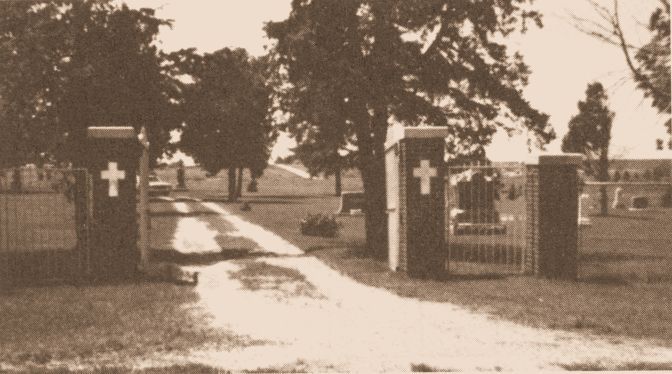
Credited with being the first settler in Burke township, he was active in the organization of that township and served as its first board chairman. To feed an ever growing family, he combined farming with the running of a stage line between Woodstock and the county hub before the railroad extended to the latter. Acquainted with sorrow, the O'Mahoneys saw four of their five children go to the grave in September, 1883. Later that same year, he became one of the two lay trustees who signed the parish's original Articles of Incorporation.
In 1901 the O'Mahoneys sold out and moved to Pipestone. Following recurrence of lung problems, Hannah died in April, 1901. Michael was laid to rest next to his beloved Hannah October 11, 1921.
While there exists no extant document of which we are aware that makes reference to the idea that the cemetery might have been named in honor of St. Bridget, there are at least three obituaries, the first in 1887 and the last in 1912, that mention specifically St. Bridget as the name for the cemetery. Because the parish population was predominantly of Irish descent, it seems reasonable that the early parishioners might have referred to their burial ground as St. Bridget. That a church and its cemetery are given names that differ is common practice.
From a brief mention made in the Woodstock News for October 25, 1912, we learn of what appears to have been the first major physical attention given the cemetery:
"A large number of residents of the Woodstock Catholic Church went out to their burying ground last Monday and again on Wednesday, and put in days hauling gravel, building driveways and walks and in other ways improving the plot. It is a good work and the combined efforts of the large crowd made a wonderful improvement."
To further enhance the cemetery, the parish purchased an acre of land from Bertha Jordan in 1929 for $100. Attached to the south side of the original plat, this acre is frequently referred to as the 'new part,' where most of the burials have taken place in recent years.
Shortly after this transaction, the iron fence, posts, and gates were constructed along the east side.
Throughout the years there have been numerous attempts to beautify the grounds with flowers, shrubbery, new trees, and the mowing of the grass that Jim Kellen recalls doing in the second half of the '40's for $60 a season. Cutting it as many as ten times annually, it would take him six hours a time if he 'raced,' an hour or so more if done leisurely; but this has all been revolutionized by the volunteer mowing done since the 1970's.
In Father Brown's time, Richard and Stella Lingen used an electronic device to thoroughly scan the plat. They located more than 80 unmarked graves, giving the lie to the wag who wrote that, "The one thing that will stick up for a man when he is down is his tombstone." All information, such as names, dates, locations, and the like, were platted on a large chart by Stella and serves as the source from which decisions can be made for new grave locations, burials already made, and who owns which lots.
In the summer of 1982, volunteers continued their diligent work in improving the plat. With many to share the labor, fifty evergreens were planted replacing those lost to wind and drought over the years. The finishing touch was when, as a fitting memorial to the dead, a crucifix was placed by two evergreen trees.
The cross was made by Edward O'Hearn and the fiberglass corpus was painted by Marlene Staloch.
The death of Christ unites the death of everyone to eternal life with the Father. Both the crucifix and the trees symbolize everlasting life.
Public Awareness
1890-1900
Early in 1890, Father Kervick was transferred from Avoca to Pipestone. He would serve at St. Leo as their resident pastor and pastor-at-large for the remaining area of Pipestone County, Woodstock being his chief mission. There must have been considerable clamor in the county, Pipestone in particular, when Father Kervic arrived. To meet him at the Omaha railway station on Tuesday evening, March 11, 1890, were parishioners and townspeople, well-wishers, and members of the hot-stove league. Though it would be a full three weeks before he had his effects removed from Avoca and finally settled, his first residence was in the Nichols house near the Catholic church, Pipestone. It is reported that he retained the "servants who were in charge of his Avoca residence."
Wasting no time in his new assignment, Father announced that there would be no services that coming Sunday at St. Leo because there were no seats in the church. The following Sunday, however, Mass was offered at St. Martin; presumably, there were seats.
In the nineties and earlier, families of Luxembourgian ancestry began moving into the parish: to name a few; John Kellen, Sr., in about 1889; Nicholas Biever, Sr., in 1889; John George, Sr., in about 1889; and Henry Kellen, Sr.. in 1890.
The nineties were a period of good times and also financial panic, anti-Catholicism, muck raking, and political experimentation. Under the aegis of the Independent Party, Patrick Gildea. running against James Jackson, won a seat in the Minnesota Legislature in 1891. A native of Ireland, he settled and farmed in Cameron Township, Murray County, and attended church at St. Martin. What is of special interest, is that Gildea is the only parishioner with a Woodstock address to have ever served in the Minnesota Legislature.
It will be remembered that back in 1885, the parish had borrowed $300 payable in three years at 10% interest, due December 1, 1888. For some unaccountable reason, that mortgage was not satisfied until December 3, 1891. But it is well that it was paid when it was, for in 1893, there began the worst depression of the nineteenth century. With low prices and poor crops, building came to a halt; it was not until 1896 that things began to pick up.
Because of a severe flu epidemic, the Lenten fast for 1892 was suspended, except for Easter week. In May, a county-wide Dorcas Society was organized at the residence of Father Kervick. The avowed purpose of the society was to teach children and adults the art of sewing and to make free clothing available to the deserving poor. Dues were $. 50: a year, lessons were $.06 each, and the organization was open to anyone, regardless of nationality or creed. Mrs. Patrick Powers was to serve as secretary for the Woodstock divisional area.
That there was some of the entrepreneur in Father Kervick there was no doubt. In June of 1893, he obtained the food concession for the encampment of the Southwestern Minnesota G.A.R. (Grand Army of the Republic). In September, he served as poultry Superintendent at the Pipestone County Fair, a position he held for at least four years.
In March of 1894, the ugly spectra of anti-Catholicism reared its head when Father Kervick, (who wrote a letter of rebuttal that appeared in the Star) was accused of stockpiling arms and ammunition in his basement. On a happier note, he began keeping chickens in April, only to have them all stolen four years later. By early June, Patrick Hartigan had trapped, gassed out, or shot enough wolves in 1894 alone to have earned almost $200 in bounty money, quite likely the best cash crop he had that year. In late June, Mabel Maguire, who had received a certain amount of musical training at the parochial school, Elkton, S.D., organized a choir at St. Martin and became the first organist of which there is any record.
By 1895, the panic (depression to us) was deepening, and there occurred the first sheriff's sale of a non-Catholic Woodstockite. That people of the era took seriously the Sunday Law is typified by the celebrated case of Delaney vs. Cheatham. One Sunday in June, John Delaney, who had a high regard for keeping holy the Sabbath had an equal abhorrence of seeing it broken. One Sunday he caught John Cheatham at work in his field. On Monday, Delaney drove to Pipestone and swore out a warrant for Cheatham’s arrest. Two days later, Cheatham was arraigned in court, found guilty, and fined $16.90.
The panic had eased up considerably by 1896. Construction resumed, and the bicycle was becoming popular, both as a vehicle of pleasure and a means of transportation for the young at heart. But alas! In late June the Maguire family moved to Pipestone, the mother taking a position as telephone operator. St Martin lost its organist.
As we move a year closer to the twentieth century, we find that 1897 was a mix of the temporal and spiritual in the parish. In February, Father Kervick was called to Baltimore to be at his father's death bed. That June, a Miss Hagan, a cousin to P.H. Powers, became the pastor's new housekeeper. Rosanna O'Neill died in September, and her funeral was one of the largest seen by the parishioners at that time.
The parish literally ran on horse power during all of the nineteenth century and well into the twentieth. When one of these beasts of burden went lame, came down with glanders and had to be destroyed, or was stolen, it was a matter of inconvenience, hardship, and loss, as seen in this account: "Thieves entered the barn of John Kellen, Sr., Burke Township, on Saturday night and took there from a dark sorrel horse, with heavy mane and tail, rather on the light order, heavy foretoe, 5 years old, front feet white to fetlocks, white strip in face, low, heavy set animal, scar on right forearm caused by wire cut, large sore on right foreshoulder, small sore on left fore-shoulder. Cards giving a description of the stolen animal have been sent in all directioned today and it is hoped that the thief will be apprehended." Whether or not the thief was apprehended is not known, but the horse was of greater importance to the nineteenth century farmer than the tractor is to his twentieth century counterpart.
In mid-November, 1897, the church underwent some repair, but no account was recorded as to its nature, but well emphasized at the time was the first apostasy when James J. Hartigan married Bessie Young out of the church. Just after Christmas a special service was held with all the frills: early communion, song, blessing, and benediction.Loretta Riffel presided at the organ. A library was added with Mrs. James O'Neill in charge.
When Father Kervick made his numerous trips between Chandler and Edgerton, he often found it necessary to engage the services of young Guy Rokes, a non-Catholic, to transport him in his father's shiny new buggy. Pick-up spot was the Omaha depot. One such time Rokes drove him to the District 56 schoolhouse, often referred to as the Shields school, where Father Kervick offered Mass, which seems strange when the Catholics had their facility in Woodstock.
Father Kervick's Christmas of 1899, would be his last in the county. His official assignment ended on February 28, 1900, the last year of the nineteenth century. The secular press was strangely silent about his departure. Could the people of the county whom he had served so faithfully for fifteen years have dismissed him without a 'whooley' (Irish for party)?
Following several assignments, mainly in the east, Father Kervick was last encountered at the Trappist Monastery, Gethsemane, Kentucky, in November, 1913, where he was the "victim of partial paralysis from muscular rheumatism" and had been obliged to give up active work." At this point, for our purposes, he dropped out of sight.
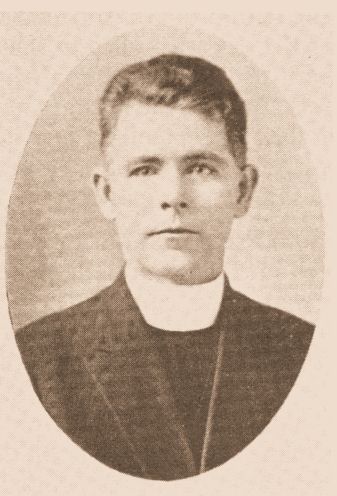
Joseph Mangan, who was born in Ireland, must have experienced an early call to the priesthood. While not quite fifteen years of age, in 1889, he was admitted to the seminary, where he studied the classics for four years, then philosophy for two years. At the invitation of Bishop Cotter, he came to Minnesota in June, 1895. He studied theology at St. Paul Seminary, St. Paul, for four years. On May 27, 1899, not quite twenty-five years old, he was ordained at St. Paul Seminary, by Bishop James Trobec for the Diocese of Winona.
In March, 1900, Father Mangan had charge of St. Martin for four months, at the same time serving St. Leo, Pipestone. At the bishop's orders, presumably, the parish purchased lot 9, Block 15, the lot north of where the rectory now stands, from two different companies. The price was $13.50 to each company, the transaction taking place April 24, 1900.
But there is more: plans and specifications had been set up; bids had been let; the result? Evidently, that house never got built. Instead, a house from somewhere in the countryside was moved in. Nevertheless, eastern Pipestone county was ready for its first resident priest.
The first wedding to take place in St. Martin Church was that of John W. Delaney and Catherine Madigan on June 5, 1900, also a first of Father Mangan. Picture is the courtesy of Margaret (Delaney) Strum of Minneapolis.
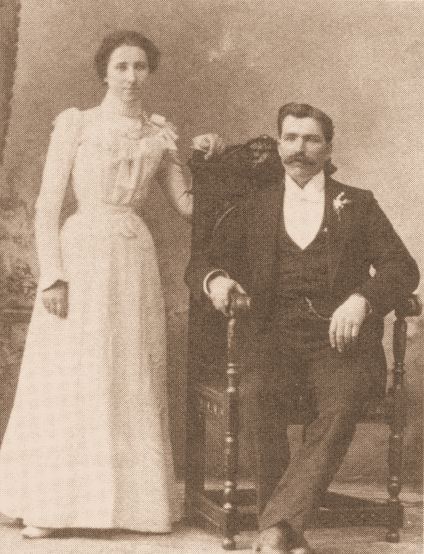
1900-1903
Daniel John Lavery was a Wisconsin native. Encouraged by the powerful example of Samuel Augustine Mazzuchilli, whose cause at the Vatican, is now moving toward canonization, he entered St. Thomas College, St. Paul, studying the classics. Later, he studied philosophy and theology at the St. Paul Seminary. He and Father Mangan, of whom you are to read more, were ordained together on May 27, 1899, by Bishop James Trobec, for the Diocese of Winona.

St. Martin was Father Lavery's first pastorate. He was well accepted in the parish and was known for his 'friendliness, his hearty greetings, and laughter.' The exact date of his arrival can only be estimated as being about July 1, 1900.
Shortly after Father's coming, there occurred a two-day religious observance (a mission perhaps?) with the Woodstock band participating. On September 2, the baptism of Catherine Ann McMahon took place, which was to be the first entry in the baptismal register. On Sunday evening, September 15, the parish staged an ice cream social, complete with recitations, short speeches, and music by the Woodstock band.
While the parish got off to a 'Marching' start during Father Lavery's first six months, there were events worthy of mention which occurred in 1901. There was an outbreak of smallpox in early March which quarantined the Sullivans, parish members. In October, Father Lavery took over the mission of St. Ann, Slayton, to which he would minister the remainder of his time in Woodstock. Hence, many baptisms recorded in St. Martin register are actually Slaytonites.
In February, 1902, a smallpox epidemic struck Woodstock, and the entire city was under quarantine. Fortunately for Father Lavery, he was ministering at St. Ann, and he missed being grounded. Toward the year's end, November 21, the parish purchased lots 10-12, Block 15. Now the east half of block was owned by the parish. Trees were planted on this property, some of which still stand.
Sometime during 1902, before Father Lavery's departure, an addition was built to St. Martin rectory. Following other assignments, Father Lavery retired to Shullsburg, Wis. in 1952, where he died in 1953.
During the interlude of a year, St. Martin would revert to a mission status. The local and diocesan churches were busy. Besides his duties as resident priest at St. Leo, Pipestone, Father Mangan, to whom you have already been introduced, took temporary charge of St. Martin in late January, 1903. As the only priest in the county, he was busy about the spiritual affairs of the Catholics in Cazenovia, Edgerton, Jasper, Pipestone, Trosky, Ruthton, and Woodstock, with trips outside the county to Avoca, Flandreau, Elkton, or Slayton, if time permitted.
The diocesan church was busy at this time, too, as Bishop Cotter paid his first official visit to Slayton, in October, confirming twenty persons. Later in October, the Church of Our Lady of Perpetual Help was organized at Kenneth, Rock County, under the laws of Minnesota.
During the past year, Father Mangan had baptized 15 persons and buried at least one person, Richard Atkins, known as Woodstock's 'millionaire.'
1904-1905
Mathias Graeve spent his youth in Westphalia, Germany. He entered St. Francis Seminary, Milwaukee, Wisconsin, in about 1898. He completed four years of theology study at St. John's Abbey, Collegeville, Minn., where he was ordained on June II, 1903.
By 1904, there were several German families in the parish, who could not speak English; consequently, a German speaking priest came about periodically to hear confessions. With the coming of Father Mathias Graeve, this need was met, and considerable support was given to those members of the parish.
A new step for the parish was the organizing of a board of trustees. Early in 1904, six men were chosen by the people and approved by the bishop. Three were German speaking, and three were English. They were J.S. Malone, J.M. O'Neill, J.P. Ryan, John Demuth, William Colling, and A. Luken. The bishop designated J.M. O'Neill as secretary and William Colling as treasurer. Father Graeve was to act as proxy for the bishop. They were to serve two years and to meet quarterly. At about the same time, John Campbell and William Holdgrafer were appointed as Advisory Council.
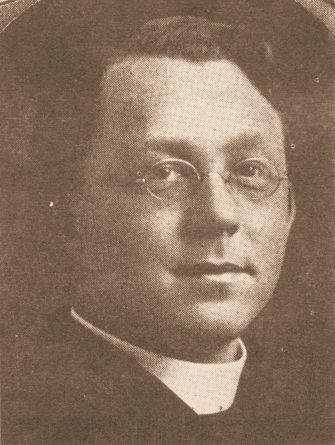
Now the group was ready to move ahead. On May 26, 1904, a decision was made to "begin work on a choir loft at once." They also adopted by-laws for the parish.
The year 1904 made a record. There were 153 days with temperatures below freezing, making it the coldest year since records had been kept.
The year, 1905, saw the first Mongolian pheasants introduced to the state, not to be hunted until 1910. Prairie chickens were so numerous that market hunters bagged about 200 a day. For the first time, the modern hunting season as we know it, made it mandatory by August that all those hunting outside the county purchase a hunter's license. Of 38 licenses, 5 went to members of St. Martin.
Because of all good things have a way of coming to an end, so Father Graeve was moved to Lismore, in October, 1905. Other assignments were Johnsburg, Adams, and lastly, Lewiston, where he died on May 29, 1938.
1905-1910
Joseph Zahner was a native of Sackville, Wisconsin. His collegiate years were spent at St. Francis Seminary, Milwaukee, and then, curiously, he transferred to St. John University, Collegeville, for the year 1896-97. The next two years at St. Paul Seminary, he studied philosophy. For his theology, he attended St. Meinard Seminary, Indiana. He was ordained June 1, 1901, by Bishop Donoghue, a full six months before his twenty-fourth birthday.
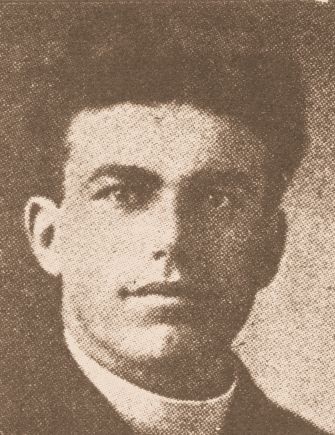
Father Zahner arrived in Woodstock in late 1905. Friendly and talkative, a bit of a tease, he took up residence in the rectory located just north of the church. This pastor, who loved to hunt, kept six or eight dogs in the house, and each day he cooked cornmeal and meat scraps for them. It is believed that he was the first resident priest to have owned an automobile.
Hardly had the dust and rubble of the San Francisco earthquake and fire (April, 1905) settled when talk began about enlarging the existing church. On September 9, the pastor and trustees agreed to honor the bid of Florence George Sullivan, a local carpenter and member of St. Martin, in the amount of $3,978. He agreed to complete the work by December 1, 1906, except for the painting and building of the top portion of the belfry, which he would finish as soon as weather would permit. Incidental items about Sullivan you may enjoy: he was Emmet O'Neill's uncle; he was editor of the Woodstock News in 1907; he had the presence of mind to snap a picture of the church before altering its appearance, and for our purpose, its reproduction, as it appeared in the News, was used earlier in this reading; and his daughter, Mrs. Veronica Purcell (age eighty) lives in Utica, N.Y.
The expansion by Sullivan and his crew consisted of the transept and sanctuary at the west end and part of the belfry at the east end. Studio art glass windows were installed during construction. On June 1, 1907, the parish took possession of the enlarged church and paid Sullivan $3,050. This was short of the amount stated in the contract, and obviously, in late November, Sullivan brought suit against the parish. The defendants argued: contract not fulfilled; poor quality workmanship; and inferior grade materials had been used. In January, 1908, the case went to district court. Pipestone, and the twelve member male jury brought in a verdict in favor of Sullivan. He received an additional $743.82, which was less than the amount he had sought. The parish had asked for some work on the rectory at the same time of construction on the church, which accounted for the discrepancy. It was a no-win, no lose situation.
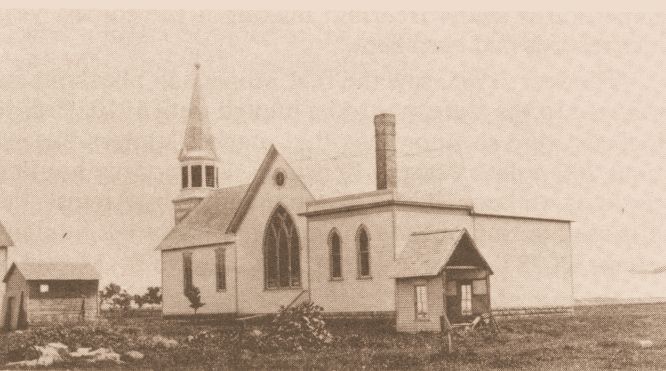
To add further to this trend of improvements and progress, a pipe organ was added. On September 7, 1907, the parish purchased lots 1-3 (Block 10) from Marie L. Bennett for $1,800, which included a two-story wood frame house that existed on those lots.
In addition to the previously mentioned lawsuit, there were other causes for sorrow: in a span of six months, the parish buried Willie Schraeder, a victim of typhoid pneumonia; in June, it was Michael Ryan, a chronic sufferer, resulting from whooping cough; and in August, it was twenty-year old Ed McMahon. Later in the summer, Chisholm (on the Mesabi Iron Range) burned to the ground, leaving six thousand homeless. The people of Pipestone County contributed money to their cause.
In late January, there occurred a two-day blizzard that paralleled the 'big storm' of 1888. But then as a requite, the parish, if not the county, swelled with pride when Father Francis O'Neill, a former member of St. Martin, offered his first Mass in St. Leo, Pipestone, on Sunday, July 4, 1909.
In the course of the same summer, St. Martin parochial school was constructed, and it was ready for occupancy in September. In the meantime, Father Zahner had vacated the rectory in favor of the house in Block 10, which for a time became the new rectory. To staff the school, the parish engaged three Sisters of St. Francis, Milwaukee, Wisconsin. They were 'comfortably settled in the former rectory,' which, as the News reported 'was fitted up for them.' Fifty eight children were enrolled, that number increasing to 72, when the older children finished the fall farm work. The figure recorded in the Official Catholic Directory, however, put the total enrollment at one hundred one.
The simple two classroom wood frame structure accommodated the younger children. The older children were housed in the church sacristy. Children in this group could have received a smattering of German among their other subjects. A third Sister acted as cook and housekeeper.
During the pleasant time of the year, the children who lived close, walked to school, while those who lived farther away drove a horse and buggy. These horses were put-up in any spare stall about the city. When cold weather set in, these distant children either returned to their respective rural schools or boarded in town. Three young girls siblings, Mary and Annie Kellen and their cousin Laura Feyereisen lived in the convent with the nuns. Upon seeing nuns for the first time, Annie fainted. After running for one year, the school closed at the end of May, 1910.
During the summer of 1910, grievances between pastor and some parishioners began to pop up. One family went so far as to sell out, crops still standing, and move away from the parish. Evidently these altercations were reported to Bishop Heffron, who paid Father Zahner an overnight visit in November. The bishop could have recognized some sort of mental, unrest, for he advised a month's rest. A natural sequence followed as Father Zahner was transferred from the parish. Could it have been that he, a Luxembourgian in descent, was experiencing a deeply seated nationality prejudice? Those who study history know that the native born Luxembourgians love the Germans as the Dutch love the sea.
Edgerton had been attached to St. Martin as a mission for most of the decade. This changed in December, 1918.
Father Zahner contracted influenza during the worldwide outbreak in late December, which developed into pneumonia. He met death at St. Elizabeth Hospital, Wabasha, on January 23, 1919. His funeral was held the next day-the authorities were desirous of interring quickly to check the spread of the disease. Remains lay in the cemetery at St. Joseph Orphanage, Wabasha.
1911-1912
St. Martin was reduced to mission status for the second time in a decade, due to the abrupt, unexplained departure of Father Zahner. During this gap, January through August, 1912, Father Mangan of St. Leo, Pipestone, was in charge. The J. F. Delaney family occupied the now empty rectory.
The spiritual affairs and material needs seemed to be moving smoothly under Father Mangan's administration. Mass was offered each Sunday at 10:30 a.m., and young people were preparing for first communion and confirmation. On Memorial Day, services were held at St. Martin, with Methodists and Presbyterians suspending theirs in this joint observance, also attended by five veterans of the War of the Rebellion, better known as the Civil War. In June, 29 children made their first communion. Concrete walks were laid about the church property in August.
Then tragedy struck the parish in rapid order. The John Ryan family lost a 3-year old daughter to diphtheria in late July, and for a time all church and social gatherings in the Woodstock area were forbidden until the danger passed. In August, Michael J. Giever died from appendicitis and in September, the Hugh Cullen family lost their two youngest to typhoid fever.
While sorrow hung over the community for a time, the parish returned to celebration that fall and on Thanksgiving Day staged an elaborate bazaar that netted the ladies $404. A traditional dinner was served at noon, a supper at 5:00 p.m., and at midnight, a second supper for the dancers who had just wound down. Meals were served in the Rock Rapids cream station, with the bazaar and dance in the opera (city) hall. The big item was the drawing that night for a hard-coal burning stove. The winner? Henry Giever.
Because Father Mangan had charge of three parishes, his responsibilities were many. Yet, he must have taken comfort when, on June 14, 1912, ninety-seven of his subjects were confirmed, the largest class in the history of the parish. Among them were many who bore family names, some of which are familiar. They were: Clarence Adams, Leo Adams, Nora Adams, Alton Bean. Henry Bennett, Mary Bennett, Mary Campbell, Clara Caulking, Mabel Caulking, Anthony Claseman, Frederick Conway, Anna Cullen, Elizabeth Cullen, John Cullen, Joseph Cullen, Mary Cullen, Francis Deick, Henry Deick, Lena Deick, Mary Deick, Raymond Delaney, Antone Demuth, Edward Demuth, Nicholas Demuth, Elizabeth Douty, Anna Fagen, Albert Feyereisen, Gabriel Feyereisen, Henry Feyereisen, Laura Feyereisen, William Feyereisen, Milo Flannery, Elizabeth George, John George, Josephine George, Nicholas George, Clara Giever, Francis Giles, John Giles, Mary Goeppel, Laura Grundler, John Grundler, Roy Grundler, Anna Hall, John Hall, Arthur Hendren, Ernest Hendren, Francis Hendren, Frederick Hendren, James Hendren, Nellie Hennessy, John Houselog, Louise Houselog, Joseph Houselog, Walter Houselog, Anna Kellen, Henry Kellen, Mary Kellen, Nicholas Kellen, John Kennard, Margaret Kennard Laura Kerby, Guy Kirsch, Leo Kirsch, Charles Malone, James Malone, John Malone, Vincent Malone, Anna Mandersheid, Lena Mandersheid, Mathew Mandersheid, Daniel Moriarity, John Moriarity, Frank Nothem, Hubert Nothem, Margaret Nothem, George Probst, Nicholar Probst, Paul Probst, Catherine Reiff, Erhart Reiff, Edward Ryan, James Ryan, Mathew Ryan, Nellie Ryan, Anna Schilling, Carl Schilling, Margaret Shea, Francis Shields, Laura Smith, Adolph Stepanek, Joseph Stepanek, Albert Tebben, Anna Tebben, Dora Tebben, and Anna Wingle.
With confirmation behind them, the parish welcomed in July the first of its six families of Dutch ancestry: the Henry Slingers, who bought a farm in Chanarambie Township; five who were to come later were, Ohlenkamp, Ossefoort, Spoelstra, Van Stelten, and Zant. That same month, Henry Kellen, Sr., bought his first automobile, a Jackson, rolled it, and never drove a car the rest of his life. In August, the farmers reaped a bumper grain crop, the best in the county to that time, and harvest hands in the vicinity received $2.50 to $3.00 per day and were hard to find at that price.
Rapport wasn’t all ‘peaching’ even though Father Mangan allowed the parish to have a St. Patrick Day dance during Lent, because he had told Winfred Bartlett, Pipestone, “If the Hennesseys don’t stop fighting among themselves, I am going to close up the parish." Undoubtedly, it was a relieved pastor who left St. Martin, but not before he offered the Mass of Christian Burial in August, for 12- year old Milo Flannery, the victim of a farm accident.
1912-1914
Twenty months had elapsed without a. resident pastor. Then, September, 1912, much to the imagined delight of the parishioners, Bishop Heffron appointed Father James Collins to St. Martin. One source stated that the people were soon to wonder how they had ever survived without a priest so very congenial and pleasant appearing. Another said that he was 'middle-aged, fleshy, and pompous.' Autocratic or not, Father Collins was to remain a full twenty two months.
The day-to-day business of the parish resumed. Much of the activity was marked by sorrow: Teddy O'Neill died of blood poisoning; Joseph Deick Jr. died of typhoid fever; Joseph Sr. followed him to the grave three months later; the grief stricken wife almost joined them shortly after, having contracted pneumonia.
There was a brighter vein. The parish was able to meet a payment to St. Mary College, Winona, for it was now fiscally sound. The school, being vacant at the time, was rented to Campbell as a residence. President Wilson authorized the observance of "Mother's Day," and it was semi-officially added to the calendar in 1914.
Father Collins knew a bit about medicine, and when young Edward Kellen languished on his bed of pain with polio, he 'doctored' him with pills. The lad took them and began to feel better.
Before departing in July, 1914, the maverick, Father Collins, had performed several baptisms and marriages. His name is listed in the Official Catholic Directory, Diocese of Winona, 1915.
1914-1922
James Donovan was born at Bandon (County Cork) Ireland. He studied the classics at St. Finbar, Cork, then transferred to St. Kiernan, Kilkenny to study philosophy. The assumption is that he sailed to United States in the summer of 1910, arriving in sufficient time to begin his study of theology at St. Paul Seminary, St. Paul until 1914. He was ordained by Bishop Heffron at St. Mary College, Winona, January 15, 1914, for the Diocese of Winona, after one short assignment, he assumed the spiritual yoke of St. Martin in July, 1914. He could not have conjectured that he would spend his pastorate equally between the world at peace and the world at war, for soon the world would be at war.
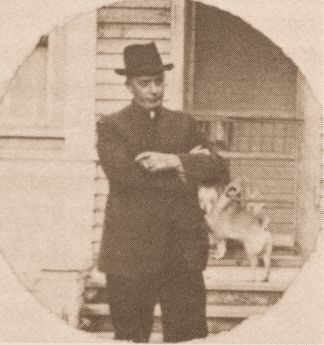
In stature, Father Donovan was a large, broad shouldered man of strength. He drove a high-back Model T; did some hunting with a re-bored muzzle gun; was somewhat stern in temperament, so the school-age children believed when he questioned them in the classroom. We also know that he was capable of dealing with trying questions, trading rebuttals when necessary, as he did when he told Elizabeth Holdgrafei , "If you go to heaven, I don't want to be there. You're too ornery." He counted among his closest friends the Henry Claseman family, who hosted him often.
Be that as it may, the parish was treated by a visit from Father Francis O'Neill in August, 1914. He celebrated Mass for his hometown friends whom he hadn't seen for nine years. In November, the parish put on its annual bazaar and fair in the opera hall.
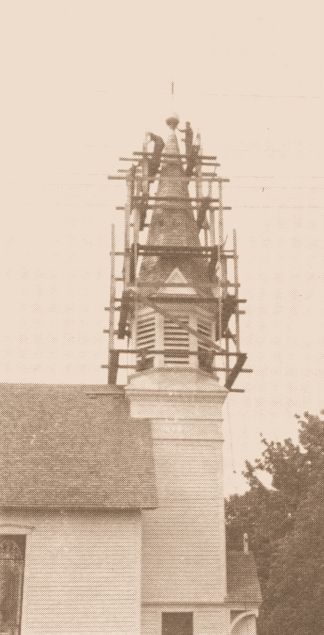
The year 1915, saw considerable improvement in the physical plant. In January, a Mr. Winter of Worthington, installed a lighting system in both the church and the rectory. The Church exterior was painted, and in September, an excerpt stated that "a force of men are busy placing new metal walls in St. Martin Church." About this same time, the belfry underwent some roof repair. Henry Reiff, con-tractor, told his helpers, Sylvester Reiff and Gabriel Feyereisen, "Don't skimp on the nails." A new bell was installed in early December.
In early February, 1916, Michael Boland, a native of Ireland, Civil War veteran, and father-in-law of Roger Ryan, breathed his last. In late July, Father Donovan, L.A. Beck, and John Giever engaged in a "three-cornered moving stunt" that changed "the location of each." Bishop Heffron was recovering from his illness crises. In November, Father Cremin of the St. Paul Seminary lectured to the people in the city hall: his subject, "Is the Catholic Church at Home in the American Republic?" This was open to everyone, admission, $1.00. Some writer (Worthington Globe) stated: there was frost every month of the year.
If 1916 was important for no other reason, it was important to Lake Wilson: St. Mary Church was organized. Charter members numbered at least twenty persons, and they made their first purchase of property.
It goes without saying that the ladies of the parish planned, executed, and served many a meal at bazaars, funerals, weddings, and on other social occasions. Over the years, their work has contributed appreciably to alleviate the financial burden of operating a church. Crowds from the surrounding areas have come to Woodstock to enjoy the food and fellowship.
During the late teens, there were nationality clashes within the Catholic parishes; to name a few; St. Paul, Shakopee, Belle Plaine, Browerville, and Perham. Aside from the fact that some cities could support two or more churches, it seems that with a few it was more because of the peoples' desire to worship in a facility of their own to avoid language problems or cultural differences. Already St. Martin had three 'camps,' but the people had the common sense not to press for separating and splitting the parish.
In 1917, the Thomas Noterman family gave up their meat-market business in Shakopee and detrained to Woodstock. Their first impression was very negative, but stay they did. Now St. Martin had four families with Belgian roots, the others were: Cauwels, Steels, and Van Heftes. In July, Margaret Shea, a local teacher and long-time church organist, moved to Pipestone. In September, the parochial school reopened.
The United States was now involved in World War l. St. Martin furnished its fair share of men during that twenty-month involvement from April, 1917 to November, 1918. One parishioner, William Tebben, remarked before leaving, "I'll be back in a box." Those words were prophetic, for he died a short time later of influenza. Doubly sad his brother Bert died (same cause) a month later. By December of that year, there were at least one-hundred cases in the Woodstock area. The scourge was worldwide, with twenty million persons having died with it.
The war brought tension among citizens, aliens, or others who might be termed Pro-German sympathizers. One such incident involved a parishioner, John Giever, who came to his place of business one March morning and found his store front windows smeared with yellow paint. The south side of the building was painted with "Pro German" in 4-foot letters. Said one citizen, "John has refused to give to the Red Cross or anything patriotic, so he had it coming." In any event, Giever's name appeared on the Loyalty League membership roll in July.




